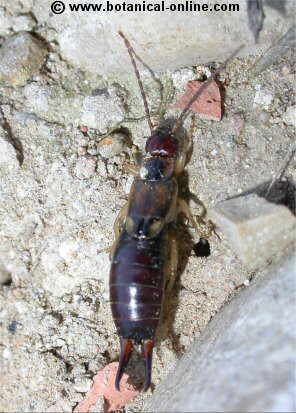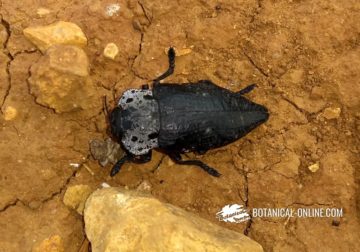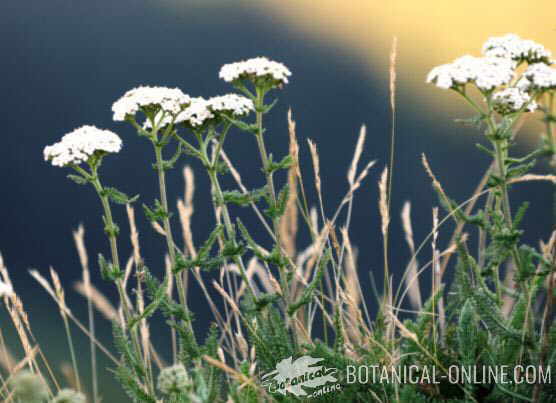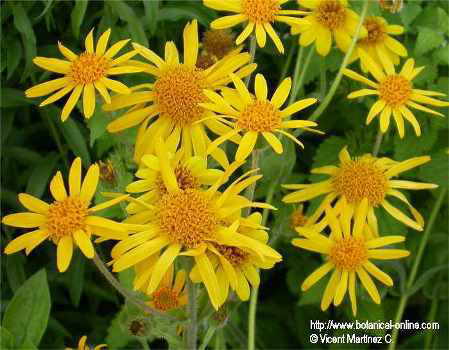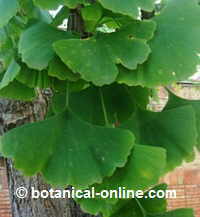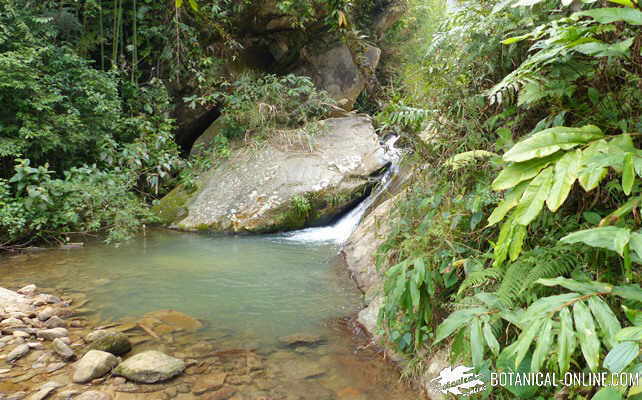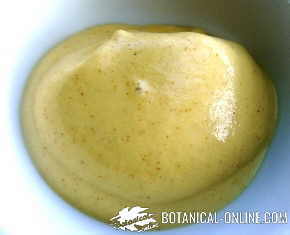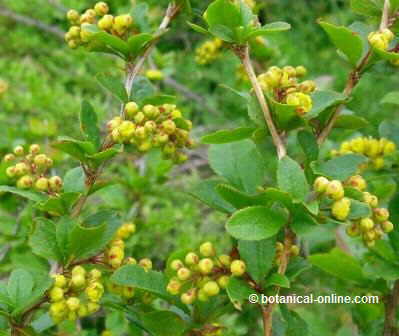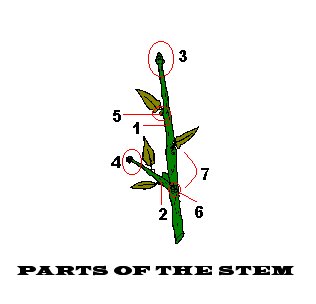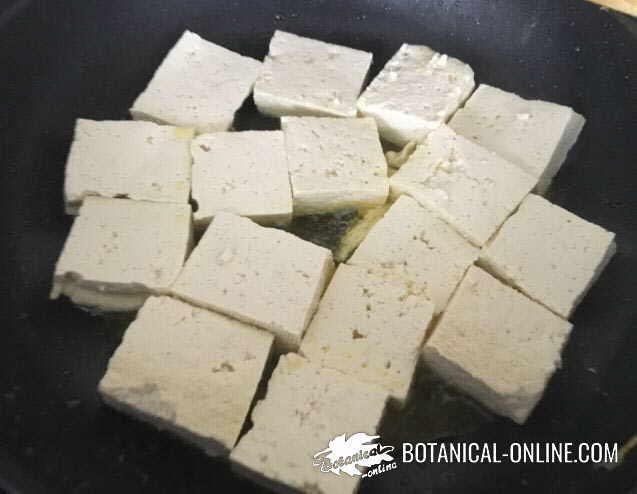Contents
Main pests and diseases of the apricot tree
 Most important pests of the apricot tree
Most important pests of the apricot tree
The main pests that affect the apricot tree are:

Earwig photo Earwigs: (Fortificula auriculata) leaves are eaten in summer. Can be removed using traps or a specific insecticide.
- Aphids: These are insects sucking mouth equipped with gadgets that feed on the sap of plants. They deposit their droppings on them that determines that these appear sticky and, in many cases, covered with ants that are attracted to the molasses. About these secretions are developed various molds. This causes discoloration and wilting of the leaves. Among the main attacking aphids have apricot peach aphid (Myzus persicae), the waxy aphid (Hyalopterus amygdali) and almond aphid (Brachycaudus helichrysi).
To combat this scourge can be washed the trees in winter with tar oil or applying insecticides such as malathion miricarb or before the leaves open.
- San Jose scale or California scale: (Quadraspidiotus perniciosus) Females have no wings and are attached to the protected plant under a shell of about 2 mm. The males have wings.
The nymphs are mobile at first with its three pairs of legs and laying down the plant after sinking her stilettos in the same resulting brownish crusts with a center on a larger white spot in the branches, leaves and fruits.
The leaves are poisoned by their saliva and fall, the fruits show no color points and twigs or shoots rot.
Prevention of pest plants involves the use of uncontaminated previously disinfected in the nursery. The treatment on the ground requires the use of oil + a suitable insecticide treatment of shock in the winter and a complementary treatment with insecticide + summer oil + copper oxiclorure 50 in summer to eliminate larvae. It has been proven the effectiveness of calcium polysulfide in summer for the treatment of this disease.
It is important in the treatment of wet winter or all branches. Do not apply to wind, or rainy days with temperatures below 5 º C.
- Codling moth: (Cydia pomonella) attacks the fruit of apple, walnut, apricot and pear. The damage is caused by larvae that penetrate into the interior of it to eat the seeds, resulting in the destruction. Treatment requires the appropriate insecticide.
- Drills: These worms with drilled device galleries that trace the host trees. Among those that affect the apricot include:

Big-headed worm photo Big-headed worm: (Capnodis tenebrionis) is a pest that affects many fruit trees. The main damages are caused by the larvae that build galleries in weakening the plant roots which eventually die. The most appropriate treatments appear to be the use of insecticides in the field for juveniles or on the branches before fruiting in early spring. Other resources have been used as biological traps feronomas.
- Goat moth: (Cossus cossus) Although primarily affects plum, can also attack other fruit trees like apricot. It is a nocturnal brown moth that can reach 8 cm in diameter with the wings open and can be seen from mid June to late August.
The larvae hatch from eggs laid about 500 females under the bark. They are crimson with yellow belly and black head, equipped with large mandibles and glands that produce a very foul-smelling discharge.
During the first year are in galleries excavated under the bark of the trunk at the neck. In the second year to penetrate into the wood. It is known that the tree is infected with the accumulated sawdust at the base of the tree. Primarily attack sick or old trees. It is necessary to apply an appropriate insecticide to eliminate them.
- Wood Leopard Moth (Zeuzera pyrina) is a type of plague that, in addition to many large trees as oak, beech, maple, willow, linden and chestnut trees, affecting mostly apple and pear trees, but may affect other fruit trees. Moth is a male of which reaches up to 6 cm with wings open. Presents the white body with 6 points of blue, the wings are also white with small blue dots.
The damage is produced by the larvae excavate galleries, which in an initial attack ends of the branches or petioles of leaves but eventually penetrate the wood and heavily damaged trees, especially old trees or in poor conditions or very young trees. In dry years the attacks are worse. The galleries open for these insects are used by other pests like beetles, red holes, etc.
To prevent the spread of healthy parts of any type of drill is necessary to prune diseased parts quickly kill if they are infective larvae in small numbers by introducing insecticide within their holes with cotton soaked or using a syringe and then plugging them. It will burn the infected wood or cut the branches that have been broken by a blow or by action of the wind.
Respect for the native fauna can help in controlling these pests. The birds are a good natural insecticide and ants eliminate many of the eggs.
 Main diseases of the apricot tree
Main diseases of the apricot tree
The main diseases affecting apricot are:
- Rust: A disease caused primarily by fungi of the genus Puccinia and Melampsora, which use the excess humidity to thrive. It manifests itself as spots of orange or brown on the underside of the leaves acquire a yellow color in the corresponding part of the beam.
The treatment involves the use of an appropriate fungicide. To avoid the appearance of the disease should increase aeration of the plant and not let the tree branches that having too many damaging internal ventilation.
- Moniliosis or flower blight (Monilia laxa) is a fungus that is mainly focused on the flowers that dry. Also produces a blackening of the fruits that are dried on the branches without falling. It is noted that the tree is infected by the appearance of cankers on the branches and the sticky liquid oozing out of some parts of the plant. It attacks mainly the almond tree, cherry tree, nectarines, plums but can affect many more fruits. The plague is higher in periods of high humidity.
The treatment involves the use of fungicides mainly rich in copper during the winter.
- Powdery mildew (Podosphaera tridactyla / Sphaerotheca pannosa) This disease is caused by fungi or Podosphaera Sphaerotheca rate. The first attacks the fruit in summer and leaves in spring. It is produced as a white spider’s web on fruits, leaves and stems. Over time these stains can become scabs. It is disease caused by infection with other plants that keep the fungus in the winter and spread their spores in spring.
The Podosphaera tridactyla attacks the leaves and young shoots in summer or autumn. Especially in the young shoots can be seen slower growth, a distortion of those that are covered with a kind of white powder. It attacks mainly apples and grapes, but can also affect other fruits such as apricots, peaches and nectarines. On the skin of the fruit produces brown spots, spider web. Resist the winter on the buds or bark of trees. Many trees are contaminated by spores carried by the wind. No need to reproduce any humidity and prefer warm temperatures and little shade to very high temperatures and full sun. It is important to prevent development of disease resistant varieties to choose, plant specimens in a well ventilated area and make a proper pruning of branches to deliver them too thick.
Watering the tree itself will help prevent the disease because the water may be able to clean the spores.
Pest prevention also involves the use of uncontaminated seedlings in a nursery previously disinfected. Field treatment requires the use of winter oil shock treatment at this station. Vegetable oils of jojoba and melia are useful if any disease in moderate or mild conditions.
In some places using a biological fungicide called AQ10. It is the parasitic fungus Ampelomyces
quisqualis that feeds at the expense of Podosphaera. Another biological treatment is the application of the bacterium Bacillus subtilis to inhibit the growth of the fungus that causes powdery mildew. Is sold under the trademark of Serenade.
Do not use sulfur on apricot trees.
- Gummosis: It is a manifestation characterized by a gummy substance oozing from the bark. You can respond to various causes, from diseases to excessive pruning, failure of any component in the substrate, adverse weather conditions, injuries etc. In many cases the gumming is an adaptation of the plant itself that covers wounds to prevent invasion of external agents.
To avoid such an event should be sought and addressed the causes that produce it.
- Eutipiosis: (Eutypa armeniacae / Eutypa lata): The most common symptoms of this disease also attacks the vine are often sudden fractures of branches in old trees and the sudden wilting of leaves. It is a cause that produces more gummy in the wounds healed pruning. Around the same is in general a lot of resin oozing chancre. Later the fungus advances towards the center of the plant and ends up killing her.
To prevent the disease is to use pruning tools previously disinfected. Try to do the pruning dry days to prevent the growth of these fungi and seek to reduce pruning old trees.
The solution is to use a fungicide paint that covered the injuries on the tree after pruning.
- Peach blight (Fusicoccum amygdali) mainly affects the almond and peach trees but may appear in the plum and apricot. It is a disease caused by the fungus Fusicoccum amygdali that causes brown and elongated cankers at the base of the knots and yolks branches of the year, leading to the strangling of them and its death by preventing the passage of the sap and by the action of the toxins of the fungus. It also attacks the leaves large brown spots.
Infection occurs through spores spread by rain penetrating wounds more or less large each of the parts of the plant or directly through the young buds.
The treatment involves removing the affected part of the plant and the use of fungicides.
![]() More information on apricot tree
More information on apricot tree

